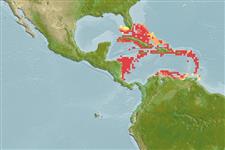>
Holocentriformes (Squirrelfishes, soldierfishes) >
Holocentridae (Squirrelfishes, soldierfishes) > Holocentrinae
Etymology: Neoniphon: Greek, neos = new + Greek, niphon = to snow (Ref. 45335).
More on author: Cuvier.
Environment: milieu / climate zone / profondeur / distribution range
Écologie
marin récifal; profondeur 1 - 70 m (Ref. 9710), usually 30 - 60 m (Ref. 9710). Tropical; 27°N - 10°N, 85°W - 60°W
Western Atlantic: Florida Keys, USA and Bahamas to Trinidad. Antilles and throughout Caribbean (Ref. 26938).
Taille / Poids / Âge
Maturité: Lm ? range ? - ? cm
Max length : 18.0 cm TL mâle / non sexé; (Ref. 26340)
Épines dorsales (Total) : 11; Rayons mous dorsaux (Total) : 12 - 14; Épines anales: 4; Rayons mous anaux: 9. Body striped with red, yellow and silver; often anterior third of body more yellow than remainder. Third anal ray spine very long and stout (Ref. 26938). Body slender, spiny dorsal fin with broad yellow band along middle and lower sides (Ref. 37108).
Body shape (shape guide): fusiform / normal.
Rarely found in shallow water, but appears to be the most common squirrelfish in the depth range of 30-60 m or more (Ref. 32). Reported used as food fish (Ref. 37108).
Life cycle and mating behavior
Maturité | Reproduction | Frai | Œufs | Fécondité | Larves
Böhlke, J.E. and C.C.G. Chaplin, 1993. Fishes of the Bahamas and adjacent tropical waters. 2nd edition. University of Texas Press, Austin. (Ref. 5521)
Statut dans la liste rouge de l'IUCN (Ref. 130435: Version 2025-1)
Menace pour l'homme
Harmless
Utilisations par l'homme
Pêcheries: intérêt commercial mineur
Outils
Articles particuliers
Télécharger en XML
Sources Internet
Estimates based on models
Preferred temperature (Réf.
123201): 23.7 - 27.7, mean 26.6 °C (based on 29 cells).
Phylogenetic diversity index (Réf.
82804): PD
50 = 0.5039 [Uniqueness, from 0.5 = low to 2.0 = high].
Bayesian length-weight: a=0.01585 (0.00766 - 0.03278), b=2.97 (2.79 - 3.15), in cm total length, based on LWR estimates for this (Sub)family-body shape (Ref.
93245).
Niveau trophique (Réf.
69278): 3.6 ±0.4 se; based on diet studies.
Résilience (Réf.
120179): Haut, temps minimum de doublement de population inférieur à 15 mois (Preliminary K or Fecundity.).
Fishing Vulnerability (Ref.
59153): Low vulnerability (10 of 100).
🛈
Nutrients (Ref.
124155): Calcium = 82.3 [37.2, 256.7] mg/100g; Iron = 0.795 [0.331, 1.616] mg/100g; Protein = 18.5 [17.3, 19.7] %; Omega3 = 0.18 [0.07, 0.43] g/100g; Selenium = 36.2 [21.2, 69.5] μg/100g; VitaminA = 76.3 [29.6, 206.6] μg/100g; Zinc = 1.5 [1.0, 2.3] mg/100g (wet weight);
